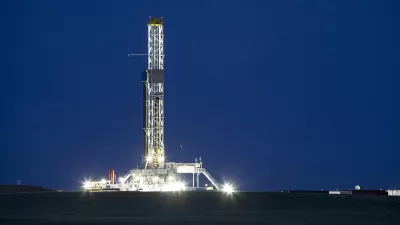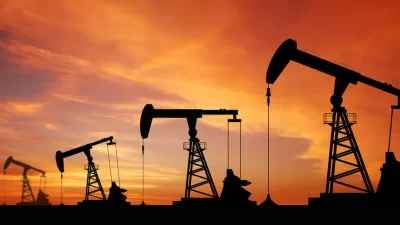A new report from the International Energy Association projects that petrochemicals will be the largest driver of oil consumption, greatly increasing greenhouse gas emissions and offsetting the effect of electric vehicles on oil demand.

"Petrochemicals – components derived from oil and gas that are used in all sorts of daily products such as plastics, fertilisers, packaging, clothing, digital devices, medical equipment, detergents and tyres – are becoming the largest drivers of global oil demand, in front of cars, planes and trucks," states a press release by the Paris-based International Energy Agency (IEA) for its major study released Friday, "The Future of Petrochemicals: Towards more sustainable plastics and fertilisers."
What about transportation?
Transportation fuel will remain the major use for petroleum, but the petrochemical industry will increasingly drive growth.
"Oil demand for transport is expected to slow by 2050 due to the rise of electric vehicles and more efficient combustion engines," report Ron Bousso and Ahmad Ghaddar for Reuters (source article). Petrochemical demand, on the other hand, will grow from 12 million barrels per day (bpd), or roughly 12 percent of total demand for oil in 2017, to almost 18 million bpd in 2050.
Petrochemicals are expected to account for more than a third of global oil demand growth by 2030 and nearly half of demand growth by 2050, according to the world's energy watchdog.
Most demand growth will take place in the Middle East and China where big petrochemical plants are being built.
Greenhouse Gas Emissions
"Petrochemicals are currently the largest industrial energy consumer and the third-largest industrial emitter of greenhouse gas emissions," reports Kendra Pierre-Louis for The New York Times on the new analysis. Steel and cement are the largest industrial emitters, respectively, although petrochemicals consume roughly as much energy as those two sectors combined, according to the executive summary [pdf].
The report found that direct greenhouse gas emissions from petrochemicals would increase 20 percent by 2030 and 30 percent by 2050.
The main driver of the petrochemical industry's growing climate footprint, according to the report, will be plastics.
Natural gas as a feedstock for petrochemicals
"Petrochemical plants mainly run on light oil products such as naphtha and liquefied petroleum gas (LPG)," add Bousso and Ghaddar. [Propane is one of a group of liquefied petroleum gases]. "But natural gas is becoming an increasingly favoured feedstock, particularly in the United States where shale gas production has risen."
Another petrochemical application is for fertilizers, "much of which is produced from natural gas," adds Pierre-Louis. "As developing countries, especially those with larger populations, increase their wealth, they will quite likely increase the use of fertilizer."
The report estimates that by 2030, roughly seven percent of increased demand in natural gas will come from petrochemical companies.
There is some irony in the increased use of oil due to petrochemicals, as the renewable energy industry is partly driving this growth.
"They are also required to manufacture many parts of the modern energy system, including solar panels, wind turbines, batteries, thermal insulation and electric vehicles," according to IEA.
Hat tip to Wall Street Journal's Energy Journal.
FULL STORY: Rising use of plastics to drive oil demand to 2050 - IEA

Alabama: Trump Terminates Settlements for Black Communities Harmed By Raw Sewage
Trump deemed the landmark civil rights agreement “illegal DEI and environmental justice policy.”

Planetizen Federal Action Tracker
A weekly monitor of how Trump’s orders and actions are impacting planners and planning in America.

How Atlanta Built 7,000 Housing Units in 3 Years
The city’s comprehensive, neighborhood-focused housing strategy focuses on identifying properties and land that can be repurposed for housing and encouraging development in underserved neighborhoods.

In Both Crashes and Crime, Public Transportation is Far Safer than Driving
Contrary to popular assumptions, public transportation has far lower crash and crime rates than automobile travel. For safer communities, improve and encourage transit travel.

Report: Zoning Reforms Should Complement Nashville’s Ambitious Transit Plan
Without reform, restrictive zoning codes will limit the impact of the city’s planned transit expansion and could exclude some of the residents who depend on transit the most.

Judge Orders Release of Frozen IRA, IIJA Funding
The decision is a victory for environmental groups who charged that freezing funds for critical infrastructure and disaster response programs caused “real and irreparable harm” to communities.
Urban Design for Planners 1: Software Tools
This six-course series explores essential urban design concepts using open source software and equips planners with the tools they need to participate fully in the urban design process.
Planning for Universal Design
Learn the tools for implementing Universal Design in planning regulations.
Caltrans
Smith Gee Studio
Institute for Housing and Urban Development Studies (IHS)
City of Grandview
Harvard GSD Executive Education
Toledo-Lucas County Plan Commissions
Salt Lake City
NYU Wagner Graduate School of Public Service





























